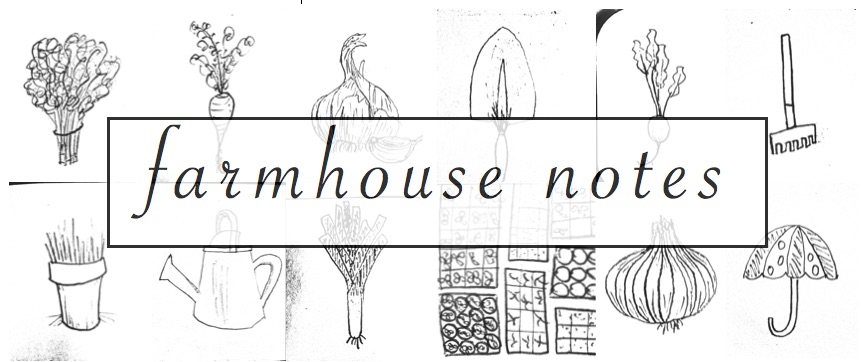This winter my dad sent me a link to Melissa Clark's rye brownies. We get rye flour sometimes from our Bluebird Grains CSA, so I tried these brownies for a party in January. It was love at first bite. These are not kid brownies, and these are not Costco brownies (that Ghiradelli mix—which I do like). These are fudgy, dense, and dark, with a rye snap in the flavor that makes me never want to consume brownies made from all-purpose flour again. I don't think they're for everyone, or even every brownie lover, but they are for me. My soul brownie.
But they do call for a lot of baking chocolate, and I didn't want to have to buy fair trade organic baking chocolate as often as I wanted to be able to make these brownies (it is just too expensive to be a basic pantry item for me). Fair trade organic cocoa powder is less expensive and goes farther. So I set out to recreate the rye brownie recipe using cocoa powder only.
I've started keeping a cooking journal where I scribble down recipes—successes and failures and musings and dinner idea lists. I added my first cocoa powder rye brownie recipe to the journal; it was a conglomeration of Melissa Clark's recipe modified by ratios I saw in cocoa powder brownie recipes online. Besides the ratios, I chose to whip the egg whites separately from everything else and fold them into the batter at the last minute, to try to balance out the lack of rise in rye flour.
Somewhat disappointingly, for I was in a test-kitchen mood, this recipe was completely and totally satisfying. It was Valentines Day, and Tim was sick with a bad cold, and we were watching What's Eating Gilbert Grape, which he had promised me would fulfill my desire for a light and romantic movie to watch that night—and it totally didn't, but it was such an amazing movie that I didn't care, and the brownies were rich and dark and chewy and we ate the whole pan (it was a mini pan).
But I couldn't just declare my brownie recipe perfect after one iteration. So for the next few months I tweaked and fiddled, tried extra eggs (too cakey), all coconut oil instead of butter (awful! Oddly crispy on the outside!), and a few other things. I kept coming back to that first recipe, with one change: no whipped egg whites. That way, the recipe takes only one bowl, about ten minutes to put together, and zero fuss. It's the kind of recipe that I can now make on whim, with no notice and no trips to the store for several $10 bars of chocolate. Like tonight, when we decided to go on a picnic at the river and I felt that we must have rye brownies to eat. Thirty minutes later, the brownies were done along with the picnic dinner and we were off. At the river's edge, after a nettle-y bushwack and wander through a mostly maple forest with ginormous old-growth stumps here and there, we consumed the brownies and I declared the recipe done. It's a monumental recipe for me—the first baking one I've patched together myself, taken all sorts of notes about and thought about many times, and tried and tested enough to feel confident in it.
So, without further ado:
Rye Brownies
10 tablespoons butter, plus more for greasing pan
3/4 cup white sugar
3/4 cup + 2 tablespoons cocoa powder
2 eggs
1 1/2 teaspoons vanilla extract
1/2 cup brown sugar
1/2 cup Bluebird Grains rye flour
1/4 teaspoon salt
1/4 teaspoon baking powder
Preheat the oven to 325 degrees F.
Combine the butter, white sugar, and cocoa powder in the bowl of a double boiler (or a heat-proof bowl set over a saucepan of boiling water). Stir until the butter is melted and the sugar and cocoa powder are smoothly incorporated. Set it aside to cool for a minute or two while you grease an 8x10-inch baking pan.
Then add the eggs, vanilla, and brown sugar, and stir to combine. Finally, add the rye flour, salt, and baking powder. I mound them on top of the butter-cocoa mixture, whisk just the dry stuff with a fork (my lazy way of avoiding getting out another bowl), and then stir it all together.
Pour into the prepared pan, use a spatula to spread it all evenly, and bake for 23-25 minutes (23 will be fudgy, and your husband might say "these aren't cooked all the way," but you will be happy) until a fork inserted in the middle comes out clean(ish).
Update, January 22, 2023:
In search of a brownie recipe for Tim’s birthday, I remembered this old recipe and dusted off the blog to check it out. It seemed just right to try again: a one-bowl recipe is even more appealing these days, and we have a plethora of rye flour for our weekly sourdough loaf. I followed the recipe exactly, with one exception—adding a generous handful of chocolate chips.
Goodness, it turned out delicious! Rich, fudgy, and just the right amount of sweet to counter the rye flavor.
I was wrong on only one point. I said “these are not kid brownies.” Did I have any kids then? Who was I to declare that? My four year old gobbled them up just as happily as me and Tim.
Maybe in the next iteration I’ll experiment with making them dairy- and egg-free, so my littlest one can partake.
For now, these are a decadent treat that I will reinstate as my go-to brownie.









